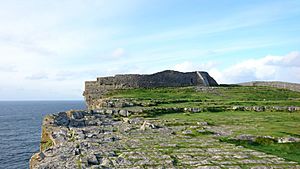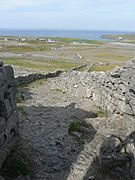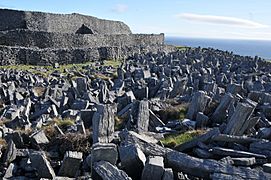Dún Aonghasa facts for kids
 |
|
| Alternative name | Dun Aengus |
|---|---|
| Location | Inis Mór |
| Region | Ireland |
| Coordinates | 53°7′33″N 9°46′5″W / 53.12583°N 9.76806°W |
| Type | hill fort/promontory fort |
| Area | 6 hectares (outer wall) |
| History | |
| Material | limestone |
| Founded | from 1100 BC |
| Periods | Bronze Age, Iron Age, early medieval |
| Site notes | |
| Public access | yes |
| Reference no. | 23 |
Dún Aonghasa (also called Dun Aengus) is a very famous old stone fort. It is one of several ancient forts found on the Aran Islands in County Galway, Republic of Ireland. This amazing site sits on Inis Mór, which is the largest of the Aran Islands. It is built right on the edge of a tall cliff, about 100 meters (330 feet) above the sea.
Dún Aonghasa is a popular place for tourists to visit. It is also a very important place for archaeologists, who study old human history.
Contents
History of Dún Aonghasa
It is not fully known exactly when Dún Aonghasa was built. However, experts now believe that most of its structures were made during the Bronze Age and Iron Age. The Bronze Age was a time when people started using bronze tools. The Iron Age followed, when iron became more common.
Archaeological digs at the site show that the first building work started around 1100 BC. At that time, people piled stones against large upright rocks to create the first enclosure. Then, around 500 BC, the fort's strong triple walls were likely added on its western side.
In the 1800s, an artist named George Petrie described Dún Aonghasa. He called it "the most magnificent barbaric monument in Europe." The name Dún Aonghasa means "Fort of Aonghas." This name might refer to an old Irish god or a mythical king. The fort has also been linked to the ancient people known as the Fir Bolg.
What Dún Aonghasa Looks Like
The fort is made up of four strong, circular walls. These walls are built from dry stone, meaning no mortar was used to hold the stones together. They sit on a high cliff, about 100 meters (330 feet) above the sea. When the fort was built, the sea level was much lower than it is today.
Some parts of the walls are still four meters (13 feet) wide. The fort was probably shaped like an oval or a "D" originally. However, over time, parts of the cliff and the fort have fallen into the sea.
Outside the third set of walls, there is a special defense system. It is made of sharp stone slabs placed upright in the ground. This is called a cheval de frise, which means "horse of Friesland" in French. It was used to stop attackers. Most of these stones are still there today.
There is also a very large rectangular stone slab inside the ruins. No one knows for sure what its purpose was. The outermost wall of Dún Aonghasa covers a huge area. It encloses about 6 hectares (14 acres) of land. This makes it one of the largest ancient ruins.
Dún Aonghasa Today
The walls of Dún Aonghasa have been rebuilt in some places. They now reach a height of 6 meters (20 feet). These rebuilt parts have walkways, rooms, and stairs. You can easily tell the difference between the old and new parts. The new parts were built using mortar, which is a type of cement.
Near the fort, there is a small museum. It tells the story of Dún Aonghasa and explains what it might have been used for. You can also find other interesting things nearby. These include a Neolithic tomb, which is a very old burial place. There is also a small heritage park. This park shows examples of a traditional thatched cottage, which has a roof made of straw.
Other Nearby Ancient Sites
There are other similar ancient sites on Inis Mór, the same island as Dún Aonghasa. These include:
- Dún Dúchathair (meaning "Black Stone Ringfort")
- Dún Eoghanachta ("Fort of the Eóganachta")
- Dún Eochla
Another fort, Dún Chonchúir ("Fort of Conchobar"), is located on the nearby island of Inis Meáin.
Image gallery
-
A view over the karst landscape on Inis Mór from Dún Aonghasa
Images for kids
See also
 In Spanish: Dún Aengus para niños
In Spanish: Dún Aengus para niños







